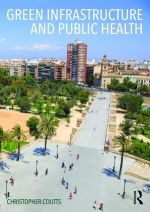Green Infrastructure and Public Health

In this book Christopher Coutts is careful to specify definitions and concepts. His definition of green infrastructure, borrowing from Mark Benedict and Edward McMahon, is “an interconnected network of greenspace [and many other representations of nature] that conserves natural ecosystem values and functions and provides associated benefits to human populations” (pages 5–6). This can include parks, of course, but also gardens, urban farms, reserves, green courtyards, and many other types of infrastructure.
And Coutts’ understanding of health is in line with the World Health Organization’s definition: of health as a more holistic state than the mere absence of disease. Thus the book tackles not just disease, but also mental health, physical activity, social capital and other determinants of healthy lifestyles.
Coutts notes that green infrastructure is essential to human health because it provides the foundation for biodiversity, which in turn is necessary for water, food, air, medicine and other ecosystem services. Water is a good example. Green infrastructure filters out pollutants that might otherwise settle in groundwater. It also keeps runoff amounts in check, thus reducing the severity of floods.
This inevitably raises the question of how climate change is affecting human health, and what role green infrastructure can play in tempering this. While such figures should be treated with care, it has been estimated that in the year 2000, climate variability was responsible for more than 150,000 deaths worldwide, predominantly of children, and the loss of 5.5 million disability-adjusted life years (pages 120–122). The mechanisms of these effects on health include:
· heatwaves (ground-level ozone exacerbates respiratory disease)
· increased mean temperature (improved conditions for disease vectors lead to an uptick in diseases like malaria)
· ozone depletion (UV radiation is associated with skin conditions)
· droughts (food shortages cause malnutrition)
· extreme weather events (lack of water safety raises the likelihood of water-borne disease)
How, then, can green infrastructure help to prevent these effects? Coutts mentions carbon sequestration, of course, yet simply adding trees to cities to capture carbon is insufficient. For one thing, a host of factors affecting urban development and consumption need to be considered. Higher-density urban settlements, for instance, may actually produce less carbon than greener, more sprawling areas. Therefore Coutts recommends integrating green infrastructure into dense urban areas, where “adding as little as 10 percent of greenspace in the form of trees in high-density development can reduce local surface temperatures by 1.4°C (2.5°F) on average” (page 132). He also argues that attempts to quantify the benefits of green infrastructure should cover a range of health benefits, such as lower healthcare costs due to pollution that urban trees have kept from being released.
Overall, Green Infrastructure and Public Health is a careful examination of the literature. It delves beyond headline figures and cautions care in interpreting them, even as it summarizes the many studies linking urban greenery to increased longevity, health equity, and quality of life.
Further reading:
Amis, Philip and Sashi Kumar (2000), “Urban economic growth, infrastructure and poverty in India: lessons from Visakhapatnam”, Environment and Urbanization Vol 12, No 1, pages 185–196, available at http://eau.sagepub.com/content/12/1/185.abstract.
Benedict, Mark A and Edward T McMahon (2002), “Green Infrastructure: Smart Conversation for the 21st Century”, Renewable Resources Journal Vol 20, No 3, pages 12–17, available at http://www.carolinamountain.org/sites/default/files/files/Nature%20and%20Commerce/2%20Final%20Version%20Renewable%20Resources%20Journal%20GI%20Article.pdf.
Listorti, James A (1999), “Is environmental health really a part of economic development - or only an afterthought?”, Environment and Urbanization Vol 11, No 1, pages 89–100, available at http://eau.sagepub.com/content/11/1/89.abstract.
Book note prepared by Christine Ro
Search the Book notes database
Our Book notes database contains details and summaries of all the publications included in Book notes since 1993 - with details on how to obtain/download.
Use the search form above, or visit the Book notes landing page for more options and latest content.
For a searchable database for papers in Environment and Urbanization, go to http://eau.sagepub.com/

